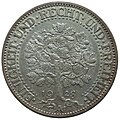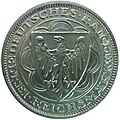Maximilian Dasio
Maximilian Dasio (born February 28, 1865 in Munich , † August 17, 1954 in Oberammergau ) was a German painter and medalist .
Life
Maximilian Dasio studied at the Munich Art Academy . From 1891 he worked as an independent artist, ran a private school for graphic arts and applied arts and was a teacher at the women's academy of the Munich Artists ' Association from 1896 to 1901 . In 1902 he became a professor at the Royal School of Applied Arts in Munich , in 1910 a government and student councilor in the Royal Ministry of the Interior for Church and School Affairs in Bavaria, and in 1920 he became a ministerial advisor in the Bavarian State Ministry for Education and Culture .
plant
Maximilian Dasio, together with Rudolf Bosselt , Georg Roemer and Benno Elkan, is considered to be a re-founder of the art of medals in Germany . He modeled his cast portraits in the style of the Renaissance . He created his most important embossed medals as an autodidact with directly engraved stamps , without the use of a reduction machine.
During the Weimar Republic , several official commemorative coins and the value side of the 5 Reichsmark course coin were minted according to Dasio's designs.
100 years of Bremerhaven . 3 and 5 RM commemorative coins from 1927.
1000 years of Nordhausen . 3 RM commemorative coin from 1927.
300th anniversary of the Magdeburg fire . 3 RM commemorative coin from 1931.
Publications
- The devil. ( Portfolio with twenty variations in woodcuts) Verlag Die Heimkehr, Munich-Pasing 1919 (hand-printed on laid paper; 50 numbered copies)
Known students
- Otto Geigenberger
- Friedrich Jossé
- Anton Kerschbaumer
- Berta Katharina Lassen
- Gabriele Münter (1877–1962), expressionist painter
- Else Oppler-Legband
- Karl Friedrich Roth
- Ottomar Starke (1886–1962), graphic artist and author
- Josef Mauder
- Carl Art
literature
- Margarete Galland: Dasio, Max. In: New German Biography (NDB). Volume 3, Duncker & Humblot, Berlin 1957, ISBN 3-428-00184-2 , p. 519 f. ( Digitized version ).
- Ingrid S. Weber: Maximilian Dasio 1865-1954. Munich painter, medalist and ministerial advisor. State Coin Collection, Munich 1985, ISBN 3-9800744-1-2 .
Web links
- Literature by and about Maximilian Dasio in the catalog of the German National Library
- Maximilian Dasio, birthday font 1920
Individual evidence
- ↑ Prof. Maximilian Dasio. Artist. German Society for Medal Art, accessed on November 2, 2015 .
- ^ L. Forrer: Biographical Dictionary of Medallists . Dasio, Maximilian. Volume VII. Spink & Son Ltd, London 1923, pp. 205 .
- ^ Paul Arnold et al .: Large German coin catalog from 1800 to today. 26th edition , Battenberg Gietl Verlag , Regenstauf 2010, pp. 534, 545, 548 and 550.
| personal data | |
|---|---|
| SURNAME | Dasio, Maximilian |
| BRIEF DESCRIPTION | German painter and medalist |
| DATE OF BIRTH | February 28, 1865 |
| PLACE OF BIRTH | Munich |
| DATE OF DEATH | 17th August 1954 |
| Place of death | Oberammergau |



